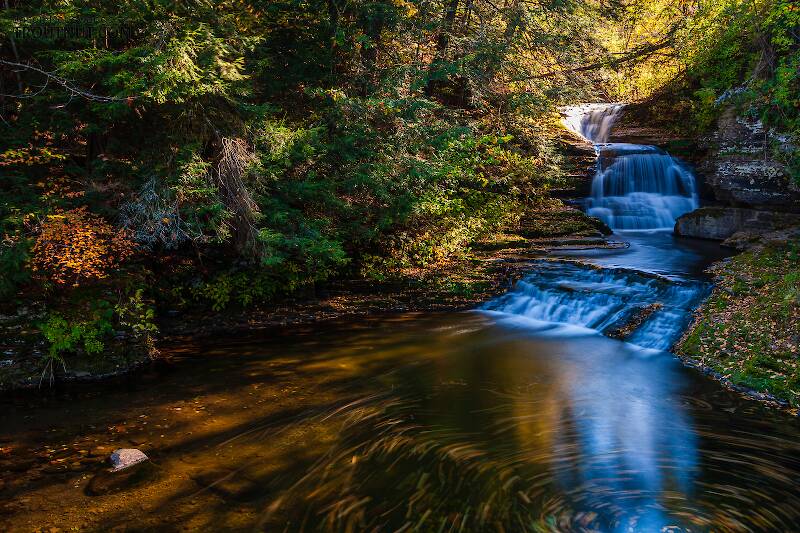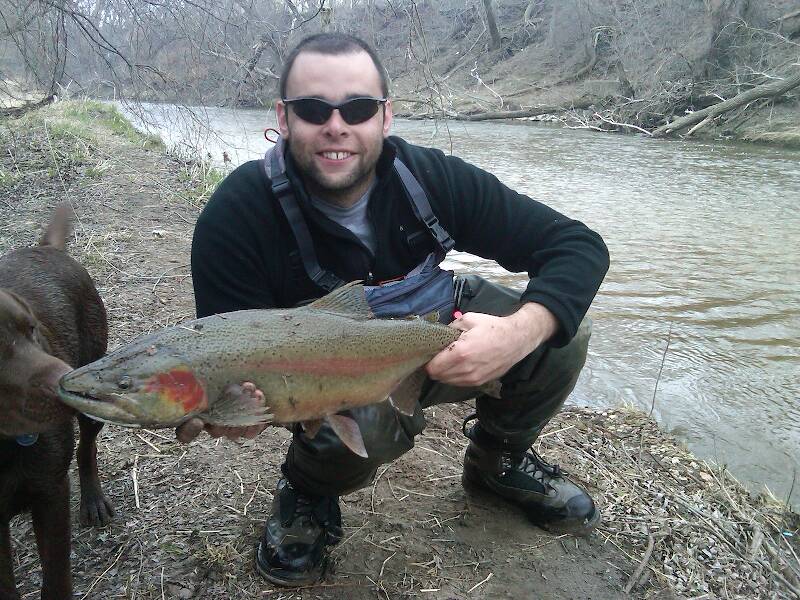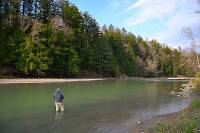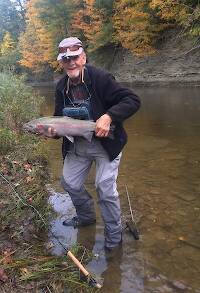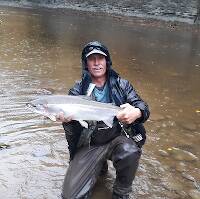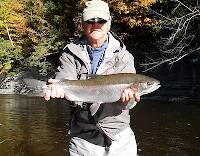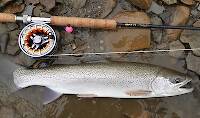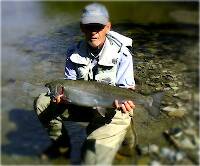
Blue-winged Olives
Baetis
Tiny Baetis mayflies are perhaps the most commonly encountered and imitated by anglers on all American trout streams due to their great abundance, widespread distribution, and trout-friendly emergence habits.
Featured on the forum

I was not fishing, but happened to be at an unrelated social event on a hill above this tiny creek (which I never even saw) when this stonefly flew by me. I assume it came from there. Some key characteristics are tricky to follow, but process of elimination ultimately led me to Sweltsa borealis. It is reassuringly similar to this specimen posted by Bob Newell years ago. It is also so strikingly similar to this nymph from the same river system that I'm comfortable identifying that nymph from this adult. I was especially pleased with the closeup photo of four mites parasitizing this one.

Troutnut is a project started in 2003 by salmonid ecologist Jason "Troutnut" Neuswanger to help anglers and
fly tyers unabashedly embrace the entomological side of the sport. Learn more about Troutnut or
support the project for an enhanced experience here.
Ike on Mar 5, 2013March 5th, 2013, 6:29 pm EST
Last fall was the first time I went steelhead fishing and although I was unsuccessful I had a great time and am gonna give it another shot this spring. I'm just looking for any information on patterns to use, techniques, what kind of water I should be fishing, etc. Also I've heard a lot about flow rates of the river making a huge difference. What is an ideal flow rate? Additional information is that I'm fishing the Boise Brule river in northern Wisconsin. Everyone I had talked to out on the water insisted I try pink eggs (which i did) but getting back to the shops I have heard nothing but stories about people having takes on large nymphs.
Wbranch on Mar 6, 2013March 6th, 2013, 12:30 am EST
Google, Google, Google. There are about a zillion web sites that discuss all aspects of steelhead fishing. You have asked so many questions in one thread that it would take many of us pages to answer. Steelheading is not difficult if you equip yourself properly in regard to tackle, flies, river & flow choice, and of course fish a river with proven good runs of fish.
I'm not at all familiar with the river you want to fish. Do you know if the predominant steelhead strain enters the river in the Fall or in the spring like the Manistee strain? That is important in that Fall fish will typically be dark and spawned out by the early spring and often will be thinner. Spring entering fish will be bright, fat, and usually very aggressive,
The two most common techniques with which I'm familiar are traditional swinging of a hairwing, or feather wing, streamer or tube fly. Here you find a suitable lie and throw a good line across the current, mend the line upstream to let the fly sink and then just follow the course of the fly down river with your rod tip. When the fly gets below you some guys just let it hang in the current for awhile and often a fish will smash it then. This can be exciting because you can often see the fish boil behind the fly.
Swinging a fly is best done on larger rivers with long pools and runs with a depth of 2' - 5'. Deeper than that and you will need some kind of heavier sink tip to get the fly deeper in the water column. Over the past few years swinging a fly has become much more popular with spey rods and switch rods and modern fly lines designed specifically for two handed rods. It is much easier to cast 60' - 70' with a 11' - 13' two handed rod than it is with a 9' fly rod.
The other common method is to nymph with, or without, an indicator. This is a great method to employ on streams of moderate width with more swift runs, riffs, and small pockets as opposed to waters with long deep runs. The streams I fish are small to medium width. From 20' - 35 ' wide and have characteristics that are just perfect for high stick nymphing. Some guys might disagree with me but I normally find my fish in the same places in-stream that I would look if I was fishing for non-migratory rainbows and browns.
Of course flow rates are important to successful steelhead fishing. I don't know what the normal cfs flow rate is for your river. Look it up on a USGS web site and see what the historical average flow is for a given period of days, or weeks, and then compare that flow rate with the current actual flow rate and that will give you an idea if the river you want to fish is low, high, or just right. I find that steelhead move out of the lakes and into the streams and river on periods of high water, like a rain event, or melting snow. When the streams get low and clear fish normally do not enter the streams and often, if they are already in, but still near the mouth, will turn around and go back into the lake. I like to fish, and have the best success, on falling high water. I have the least success, and the most difficult fishing, when the water is low and clear and I can plainly see the fish.
Regarding your choice of flies it's pretty obvious that steelhead love to eat eggs! So you should either start tying, or buying, the various egg patterns in sizes #10 - #16. Normally dirty water = bigger flies, clear water = smaller flies. I'd buy/tie Glo-bugs, Blood Dots, Sucker Spawn, Krystal Meth, Nuclear Eggs, and Estaz eggs in all the typical colors of salmon eggs as well as some of the more unusual colors.
What kind of nymphs are common in the waters you are planning to fish? I bet there are plenty of stoneflies so you should be stocking up on flies that look like those bugs. I don't think you can go wrong with any black or brown stonefly pattern. I find that steelhead are far less fussy compared to regular trout so the flies you use don't have to be close replicas. More important is it's general overall size and proportion and that it has features that will allow it to look lifelike in the water. I also like Hare's Ears in black, reddish brown, dark natural, and light natural in sizes #8 - #18. Flashback PT's same sizes, Prince nypmphs #10 - #16.
IMO if you want action rather than tradition I would ask around and find out what streams, besides the Brule, have good runs of fish. Then I'd try to schedule a trip with good water conditions and not so cold that you freeze your butt off. I'd go there with a 9 ' - 10' single handed rod with a WF#7 floating line with a 9'- 10' 3X or 4X leader, add some BB's to the tag end of the blood knot where you tied on a tippet, and tie on one stonefly and one egg fly below it about 12" (if it is legal in your state to use two flies). Then I'd look for a suitable run 2'- 3' deep with good cover on the bottom, not too clear, and start at the head and start to short line nymph it with, or without, an indicator. Concentrate and keep focused and if you aren't getting hung up once in awhile you probably aren't deep enough. 95% of the time I see steelhead sitting either on or within an inch or two of the bottom. So you must keep the fly down on the bottom, not above the fishes head. Once in awhile I do see suspended fish and that can be exciting because you are sight casting and it is really neat to see a flash of white as they open their mouuth to take the fly or your indicator dips as it passes by the fish. Good luck. PM me if you want any more info.
I'm not at all familiar with the river you want to fish. Do you know if the predominant steelhead strain enters the river in the Fall or in the spring like the Manistee strain? That is important in that Fall fish will typically be dark and spawned out by the early spring and often will be thinner. Spring entering fish will be bright, fat, and usually very aggressive,
The two most common techniques with which I'm familiar are traditional swinging of a hairwing, or feather wing, streamer or tube fly. Here you find a suitable lie and throw a good line across the current, mend the line upstream to let the fly sink and then just follow the course of the fly down river with your rod tip. When the fly gets below you some guys just let it hang in the current for awhile and often a fish will smash it then. This can be exciting because you can often see the fish boil behind the fly.
Swinging a fly is best done on larger rivers with long pools and runs with a depth of 2' - 5'. Deeper than that and you will need some kind of heavier sink tip to get the fly deeper in the water column. Over the past few years swinging a fly has become much more popular with spey rods and switch rods and modern fly lines designed specifically for two handed rods. It is much easier to cast 60' - 70' with a 11' - 13' two handed rod than it is with a 9' fly rod.
The other common method is to nymph with, or without, an indicator. This is a great method to employ on streams of moderate width with more swift runs, riffs, and small pockets as opposed to waters with long deep runs. The streams I fish are small to medium width. From 20' - 35 ' wide and have characteristics that are just perfect for high stick nymphing. Some guys might disagree with me but I normally find my fish in the same places in-stream that I would look if I was fishing for non-migratory rainbows and browns.
Of course flow rates are important to successful steelhead fishing. I don't know what the normal cfs flow rate is for your river. Look it up on a USGS web site and see what the historical average flow is for a given period of days, or weeks, and then compare that flow rate with the current actual flow rate and that will give you an idea if the river you want to fish is low, high, or just right. I find that steelhead move out of the lakes and into the streams and river on periods of high water, like a rain event, or melting snow. When the streams get low and clear fish normally do not enter the streams and often, if they are already in, but still near the mouth, will turn around and go back into the lake. I like to fish, and have the best success, on falling high water. I have the least success, and the most difficult fishing, when the water is low and clear and I can plainly see the fish.
Regarding your choice of flies it's pretty obvious that steelhead love to eat eggs! So you should either start tying, or buying, the various egg patterns in sizes #10 - #16. Normally dirty water = bigger flies, clear water = smaller flies. I'd buy/tie Glo-bugs, Blood Dots, Sucker Spawn, Krystal Meth, Nuclear Eggs, and Estaz eggs in all the typical colors of salmon eggs as well as some of the more unusual colors.
What kind of nymphs are common in the waters you are planning to fish? I bet there are plenty of stoneflies so you should be stocking up on flies that look like those bugs. I don't think you can go wrong with any black or brown stonefly pattern. I find that steelhead are far less fussy compared to regular trout so the flies you use don't have to be close replicas. More important is it's general overall size and proportion and that it has features that will allow it to look lifelike in the water. I also like Hare's Ears in black, reddish brown, dark natural, and light natural in sizes #8 - #18. Flashback PT's same sizes, Prince nypmphs #10 - #16.
IMO if you want action rather than tradition I would ask around and find out what streams, besides the Brule, have good runs of fish. Then I'd try to schedule a trip with good water conditions and not so cold that you freeze your butt off. I'd go there with a 9 ' - 10' single handed rod with a WF#7 floating line with a 9'- 10' 3X or 4X leader, add some BB's to the tag end of the blood knot where you tied on a tippet, and tie on one stonefly and one egg fly below it about 12" (if it is legal in your state to use two flies). Then I'd look for a suitable run 2'- 3' deep with good cover on the bottom, not too clear, and start at the head and start to short line nymph it with, or without, an indicator. Concentrate and keep focused and if you aren't getting hung up once in awhile you probably aren't deep enough. 95% of the time I see steelhead sitting either on or within an inch or two of the bottom. So you must keep the fly down on the bottom, not above the fishes head. Once in awhile I do see suspended fish and that can be exciting because you are sight casting and it is really neat to see a flash of white as they open their mouuth to take the fly or your indicator dips as it passes by the fish. Good luck. PM me if you want any more info.
Catskill fly fisher for fifty-five years.
Kschaefer3 on Mar 6, 2013March 6th, 2013, 4:37 am EST
I have fished the Brule many times, but have yet to catch a fish. The fish are not easy to catch out of there even when flows are good. I usually fish a larger x-legs stonefly pattern with an egg of any color trailing. Or go stonefly to soft hackle and swing it at the end of my drift. If I had any sort of success I would offer more information. Maybe I should tell you exactly what I do, and you can do the opposite.
Quick Reply
Related Discussions
Topic
Replies
Last Reply
Re: Sorry folks tourney cancelled due to outrageously high and dangerous water
In General Discussion by Pryal74
In General Discussion by Pryal74
1
Nov 24, 2010
by Pryal74
by Pryal74

